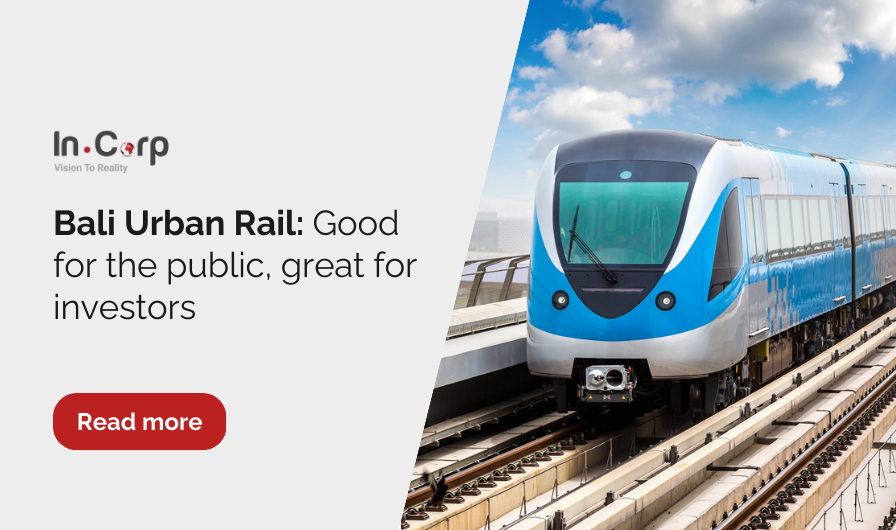Bali is on the verge of a transportation revolution. The Subway Bali Urban Rail project will present opportunities for investors. The plan for designing a subway in Bali can be seen as a new way to capitalize on an infrastructure project that will redefine mobility within the island.
This ambitious undertaking promises to alleviate traffic congestion, enhance connectivity, and unlock new economic potential for Bali.
Bali’s rising need for improved transportation
Congestion poses a significant problem for Bali’s tourism industry. Bali will be equipped with rail-based mass transportation facilities to address this. The subway will move people from Denpasar City, Badung Regency, Gianyar Regency, and Tabanan Regency, collectively known as Sarbagita.
This development plan for the subway in Bali was announced by the Minister of National Development Planning and Head of the National Development Planning Agency (Bappenas), Suharso Monoarfa, during a ceremony at the Wiswa Sabha Building, Bali Governor’s Office, in Denpasar City on Wednesday, May 29, 2024.
The event focused on conveying investment interest in the Subway Bali Urban Rail and associated facilities and submitting qualification documents.
Number of foreign visitors in Bali

By March 2024, the number of international tourists visiting Bali had surged to 1.34 million, substantially increasing from 51 visitors in 2021. The drop in foreign tourist arrivals in 2021 was attributed to the impact of the COVID-19 pandemic.
The difference between the Bali Urban Rail and the Bali LRT project
The Director General of Railways at the Ministry of Transportation (Kemenhub), Risal Wasal, stated that the Bali LRT is part of the Bali Urban Rail development plan for mass transportation in Bali.
The investment for the Bali Urban Rail project is estimated to be around USD 876 million or approximately USD 14.2 trillion. The first phase, Bali LRT 1A, will have a track length of 6.04 kilometers. The route of the Bali subway will extend from I Gusti Ngurah Rai Airport to Sunset Road.
In this initial phase, the Bali LRT will have five stations: Ngurah Rai Airport, Kuta, Pura Desa Adat, Central Park, and Sunset Road.
Bali Urban Rail project: Why should you invest?
The Acting Governor of Bali, Sang Made Mahendra Jaya, announced that Jamkrida Bali Mandara and Sarana Bali Dwipa Jaya (SBDJ) have been designated to develop the infrastructure for Bali’s new subway mass transit system.
Eight major investors have expressed interest to date, including three from Europe, two from China, one from Malaysia, and two from Indonesia. While Ari Askhara, President Director SBDJ, stated that three investors have shown interest.
These include an Indonesian consortium, PT Bumi Indah Prima, in collaboration with a Chinese company, the French RATP Group, and the Siemens Group from Germany.
The exact investment amount for the subway development in Bali has yet to be determined, but verbal commitments from one investor have reached up to USD 20 billion.
In addition, Ari explained that the Subway Bali Urban Rail route plan, according to one of the submitted proposals, consists of three phases:
- Phase 1 covers Ngurah Rai – Kuta – Seminyak – Canggu – Cemagi – Munggu
- Phase 2 includes Kuta – Renon – Sanur – Ubud
- Phase 3 encompasses Kuta – Nusa Dua
Read more: Start tourism investment in Bali and Lombok
Factors to consider in the Subway Bali Urban Rail project
The Bali Urban Rail project is an ambitious initiative that faces various challenges and holds significant potential. Several key factors influence the feasibility of this project:
1. The need for transportation
Bali is one of Indonesia’s top tourist destinations, and traffic congestion is increasing, particularly in tourist areas such as Kuta, Seminyak, and Ubud. The presence of a subway in Bali can reduce traffic jams, enhance transportation comfort for locals and tourists, and lower carbon emissions.
2. Investment and funding
Large projects like urban rail require substantial investment from both government and private sectors. Funding sources include government budgets, private investors, international loans, and public-private partnership (PPP) schemes.
3. Technical and economic studies
Feasibility studies, including technical, economic, social, and environmental analyses, are necessary to ensure the project’s viability. Population density, travel patterns, and population growth projections must be considered.
4. Infrastructure and technology
Existing infrastructure, including land, stations, and railway technology, must support the construction of rail lines. The adoption of efficient and environmentally friendly modern technology must also be considered.
5. Government support and regulation
The support of both central and local governments is crucial for the success of the Bali Urban Rail project. Clear and consistent regulations and policies, including licensing and transportation policies, are essential.
6. Community support
Local community participation and support are vital for the Bali Urban Rail project’s success. Public outreach and consultation must be conducted to ensure community support and understanding of the project’s benefits.
7. Environmental challenges
Bali’s natural beauty must be preserved. The project must be designed to avoid damaging the environment and Bali’s natural charm. Environmental impact studies must be conducted earnestly, and mitigation plans must be implemented.
If all these factors are carefully considered and managed, this Bali Urban Rail project can become a reality and benefit Bali significantly. This mega project could be an effective and sustainable transportation solution.
Invest in the Bali Urban Rail project with InCorp
The development of the Bali Urban Rail is expected to increase Bali tourism significantly. This increase in tourism will create prime opportunities for businesses to establish themselves on the island.
InCorp offers comprehensive services to ensure a smooth business setup, including company incorporation and Investor KITAS assistance.
Our end-to-end support covers every aspect of establishing your business, from initial incorporation to obtaining necessary permits. This enables you to focus on tapping into the growing market and reaping the benefits of Bali’s enhanced tourism infrastructure.
Get in touch with us.
What you'll get
A prompt response to your inquiry
Knowledge for doing business from local experts
Ongoing support for your business
Disclaimer
The information is provided by PT. Cekindo Business International (“InCorp Indonesia/ we”) for general purpose only and we make no representations or warranties of any kind.
We do not act as an authorized government or non-government provider for official documents and services, which is issued by the Government of the Republic of Indonesia or its appointed officials. We do not promote any official government document or services of the Government of the Republic of Indonesia, including but not limited to, business identifiers, health and welfare assistance programs and benefits, unclaimed tax rebate, electronic travel visa and authorization, passports in this website.



